Punjab State Board PSEB 11th Class Chemistry Book Solutions Chapter 1 Some Basic Concepts of Chemistry Exercise Questions and Answers.
PSEB Solutions for Class 11 Chemistry Chapter 1 Some Basic Concepts of Chemistry
PSEB 11th Class Chemistry Guide Some Basic Concepts of Chemistry InText Questions and Answers
Question 1.
Calculate the molecular mass of the following:
(i) H2O (ii)CO2 (iii) CH4
Answer:
(i) H2O
The molecular mass of water (H20)
= (2 x Atomic mass of hydrogen) + (1 x Atomic mass of oxygen)
= [2(1.008 u) +1(16.00 u)]
= 2.016u +16.00u = 18.016 u=18.02u
(ii) CO2
The molecular mass of carbon dioxide (CO2)
= (1 x Atomic mass of carbon) + (2 x Atomic mass of oxygen)
= [1(12.011u) + 2(16.00u)]
= 12.011u + 32.00u = 44.01u
(iii) CH4
The molecular mass of methane (CH4)
= (1 x Atomic mass of carbon) + (4 x Atomic mass of hydrogen)
– [1(12.011u) + 4(1.008u)]
= 12.011u + 4.032u = 16.043u
![]()
Question 2.
Calculate the mass per cent of different elements present in sodium sulphate (Na2SO4).
Answer:
The molecular formula of sodium sulphate is Na2SO4
Molar mass of Na2SO4 = 2 x Atomic mass of Na + 1 x Atomic mass of S + 4 x Atomic mass of O
= [(2 x 23.0) + (1 x 32.066) + (4 x 16.00)]
= 46.0 + 32.066 + 64.00 = 142.066 g
Mass per cent of sodium
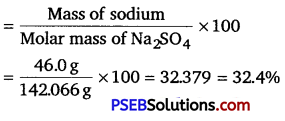
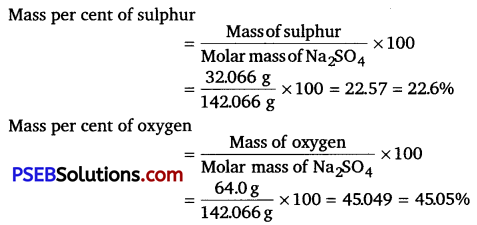
Question 3.
Determine the empirical formula of an oxide of iron which has 69.9% iron and 30.1% dioxygen by mass.
Answer:

Question 4.
Calculate the amount of carbon dioxide that could be produced when
(i) 1 mol of carbon is burnt in air
(ii) 1 mole of carbon is burnt in 16g of dioxygen
(iii) 2 moles of carbon are burnt in 16g of dioxygen
Answer:

∵ 32.0g of O2 produce 44.0 g of CO2
∵ 16.0 g of O2 produce = \(\frac{44}{32}\) x 16 = 22.0 g of CO2
Amount of CO2produced = 22.0g
(iii) Amount of CO2produced when 2 moles (= 24 g) of C are burnt in 16.0g (limited amount ) of O2 = 22.0g
Question 5.
Calculate the mass of sodium acetate (CH3COONa) required to make 500mL of 0.375 molar aqueous solution. Molar mass of sodium acetate is 82.0.245 g mol-1.
Answer:
0.375M aqueous solution of sodium acetate = 1000mL of solution containing 0.375 moles of sodium actate
∴ Number of moles of sodium acetate in 500 mL.
= \(\frac{0.375}{1000}\) x 500 = 0.1875 mole.
Molar mass of sodium acetate = 82.0245 g mol-1
∴ Required mass of sodium acetate
= 82.0245 g mol-1 x 0.1875 mole
= 15.38 g
Question 6.
Calculate the concentration of nitric acid in moles per litre in a sample which has a density, 1.41 gmLT1 and the mass per cent of nitric acid in it being 69%.
Answer:
Mass percent of nitric acid in the sample = 69%
Thus, 100 g of sample contains 69 g of nitric acid
Molar mass of nitric acid (HNO3)
= {1 +14 + 3(16)} g mol-1
= 1 +14 + 48 = 63 g mol-1
∴ Number of moles in 69 g of HNO3
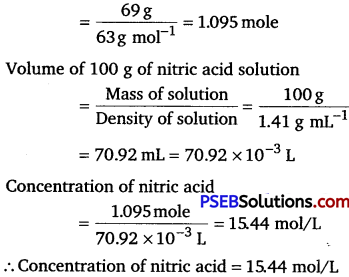
![]()
Question 7.
How much copper can be obtained from 100 g of copper sulphate (CuSO4)?
Answer:
1 mole of CuSO4 contains 1 mole of copper.
Molar mass of CuSO4
= (63.5) + (32.00) + 4(16.00)
= 63.5 + 32.00 + 64.00 = 159.5 g mol-1
159.5 g of CuSO4 contains = 63.5 g of copper
=> 100 g of CuSO4 contains = \(\frac{63.5 \times 100 \mathrm{~g}}{159.5}\) = 39.81g
∴ Mass of copper that can be obtained from 100 g of CuSO4 = 39.81 g
Question 8.
Determine the molecular formula of an oxide of iron in which the mass per cent of iron and oxygen are 69.9 and 30.1 respectively.
Answer:
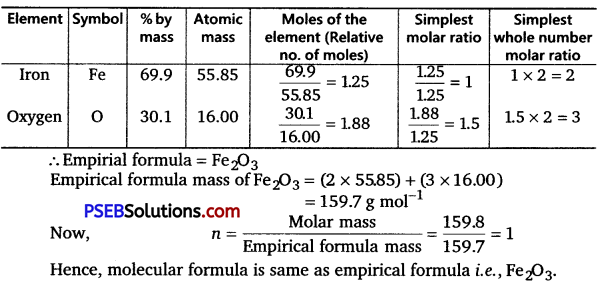
Question 9.
Calculate the atomic mass (average) of chlorine using the following data:
| % Natural Abundance | Molar Mass | |
| 35cl | 75.77 | 34.9689 |
| 37Cl | 24.23 | 36.9659 |
Answer:
The average atomic mass of chlorine
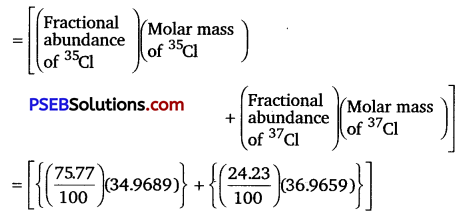
= 26.4959 + 8.9568 = 35.4527
∴ The average atomic mass of chlorine = 35.4527
Question 10.
In three moles of ethane (C2H6), calculate the following:
(i) Number of moles of carbon atoms.
(ii) Number of moles of hydrogen atoms.
(iii) Number of molecules of ethane.
Answer:
(i) 1 mole of C2H6 contains 2 moles of carbon atoms.
∴ 3 moles of C2H6 will contain = 2 x 3 = 6 moles of carbon atoms
(ii) 1 mole of C2H6 contains 6 moles of hydrogen atoms.
∴ 3 moles of C2H6 will contain =3 x 6 = 18 moles of hydrogen atoms
(iii) 1 mole of C2H6 contains 6.022 x 1023 molecules of ethane.
∴ 3 moles of C2H6 will contain = 3 x 6.022 x 1023
= 18.066 x 1023 molecules of ethane
Question 11.
What is the concentration of sugar (C12H22O11) in mol L-1 if 20 g of sugar are dissolved in enough water to make a final volume up to 2 L?
Answer:
Molar mass of sugar (C12H22O11)
= 12 x 12 + 22 x 1 +11 x 16 = 342 g mol-1
Molar concentration = \(\frac{\text { Moles of solute }}{\text { Volume of solution in L }}=\frac{0.0585}{2 \mathrm{~L}}\)
= 0.0293 mol L-1 = 0.0293 M
Question 12.
If the density of methanol is 0.793 kg L-1, what is its volume needed for making 2.5 L of its 0.25 M solution?
Answer:
Final volume, V2 = 2.5 L
Final molarity, M2 = 0.25 M
Density of methanol = 0.793 kg L-1
Molarity of initial solution M1 = ?
Initial volume, V1 = ?
Molar mass of methanol (CH3OH) = (1 x 12) + (4 x 1) + (1 x 16)
= 32 g mol-1 = 0.032 kg mol-1
Molarity of methanol solution, M1 = \(\frac{0.793 \mathrm{~kg} \mathrm{~L}^{-1}}{0.032 \mathrm{~kg} \mathrm{~mol}^{-1}}\) = 24.78 mol L-1
Applying,
M1V1 = M2V2
(24.78 mol L-1)V1 = (2.5L) (0.25mol L-1)
V1 = 0.02522 L
V1 = 25.22 mL
![]()
Question 13.
Pressure is determined as force per unit area of the surface. The SI unit of pressure, pascal is as shown below :
1 Pa= IN m-2
If mass of air at sea level is 1034 g cm-2, calculate the pressure in pascal.
Answer:
Pressure is defined as force acting per unit area of the surface.
i.e, P = F/A

= 101332.0 Nm-2 [1N = 1kg ms-2]
∴ Pressure = 1.01332 x 10 5
Question 14.
What is the SI unit of mass? How is it defined?
Answer:
The SI unit of mass is kilogram (kg).
1 kilogram is defined as the mass equal to the mass of the international prototype of kilogram.
Question 15.
Match the following prefixes with their multiples :
| Prefixes | Multiples | |
| (i) | micro | 106 |
| (ii) | deca | 109 |
| (iii) | mega | 10-6 |
| (iv) | giga | 10-15 |
| (v) | femto | 10 |
Answer:
| Prefixes | Multiples | |
| (i) | micro | 10-6 |
| (ii) | deca | 10 |
| (iii) | mega | 106 |
| (iv) | giga | 109 |
| (v) | femto | 10-15 |
Question 16.
What do you mean by significant figures?
Answer:
The number of significant figures in a given data is the number of all certain digits plus one uncretain digit.
For example, if 15.6 mL is the result of an experiment, then 15 is certain while 6 is uncertain, and the total number of significant figures are 3.
Question 17.
A sample of drinking water was found to he severely contaminated with chloroform, CHC13, supposed to he carcinogenic in nature. The level of contamination was 15 ppm (by mass).
(i) Express this in per cent by mass.
(ii) Determine the molarity of chloroform in the water sample.
Answer:
(i) ∵ 106 g of solution contains 15 g of CHCl3
∴ 1 g of solution contains = \(\frac{15}{10^{6}}\) g of CHCl3
100 g of solution contains = \(\frac{15}{10^{6}}\) x 102 = 15 x 10-4 g of CHCl3
∴ Percent by mass = 0.0015%
(ii) Molar mass of CHCl3 = 12 +1 + 3 x 35.5 = 119.5 g mol-1
0.0015% means 15 x 10-4 g chloroform is present in 100 g sample.
Molarity = \(\frac{W \times 1000}{m \times \text { Volume of sample }}\)
[For water density = 1 g cm-3; so mass = volume]
= \(\frac{15 \times 10^{-4} \times 1000}{119.5 \times 100}\)
= 1.25 x 10-4 M
![]()
Question 18.
Express the following in the scientific notation :
(i) 0.0048
(ii) 234000
(iii) 8008
(iv) 500.0
(v) 6.0012
Answer:
(i) 0.0048 = 4.8 x 10-3
(ii) 234000 = 2.34 x 105
(iii) 8008 = 8.008 x 103
(iv) 500.0 = 5.00 x 102
(v) 6.0012 = 6.0012 x 100
Question 19.
How many significant figures are present in the following?
(i) 0.0025
(ii) 208
(iii) 5005
(iv) 126000
(v) 500.0
(vi) 2.0034
Answer:
(i) 0.0025
There are 2 significant figures,
(ii) 208
There are 3 significant figures.
(iii) 5005
There are 4 significant figures.
(iv) 126000
There are 3 significant figures.
(v) 500.0
There are 4 significant figures.
(vi) 2.0034
There are 5 significant figures.
Question 20.
Round up the following upto three significant figures :
(i) 34.216 (ii) 10.4107
(iii) 0.04597 (iv) 2808
Answer:
(i) 34.2
(ii) 10.4
(iii) 0.0460
(iv) 2810
Question 21.
The following data are obtained when dinitrogen and dioxygen react together to form different compounds :
| Mass of dinitrogen | Mass of dioxygen | |
| (i) | 14 g | 16 g |
| (ii) | 14 g | 32 g |
| (iii) | 28 g | 32 g |
| (iv) | 28 g | 80 g |
(a) Which law of chemical combination is obeyed by the above experimental data? Give its statement.
(b) Fill in the blanks in the following conversions :
(i) 1 km = ………mm = ………pm
(ii) 1 mg = ………kg = ………ng
(iii) 1 mL = ………L = ………dm3
Answer:
On fixing the mass of dinitrogen as 14 g, then the masses of dioxygen which combines with the fixed mass (= 14 g) of dinitrogen will be 16, 32, 16, 40 which are in the simple whole number ratio of 1 : 2 : 1 : 2.5 or 2 : 4 : 2 : 5.
(a) Law of multiple proportions : This law was proposed by Dalton in 1803. According to this law, if tvo elements can combine to form two or more than two compounds, the masses of one element that combine with a fixed mass of the other element are in the ratio of small whole numbers.
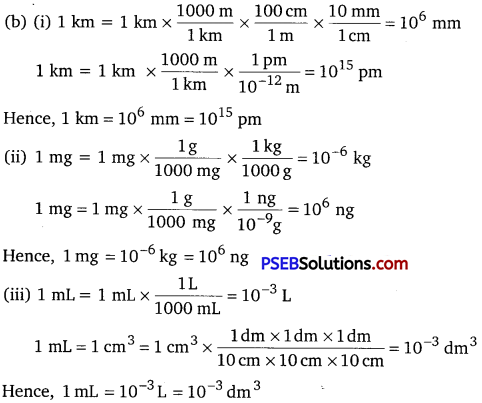
![]()
Question 22.
If the speed of light is 3.0 x 108ms-1, calculate the distance covered by light in 2.00 ns.
Answer:
According to the question,
Time taken to cover the distance = 2.00 ns
2ns = 2.00 x 10-9s [∵ 1ns = 10-9s]
Speed of light = 3.0 x 108ms-1
Distance travelled by light in 2.00 ns
= Speed of light x Time taken
= (3.0 x 108ms-1)(2.00 x 10-9s) = 6.00 x 10-1 m = 0.6 m
Question 23.
In a reaction A + B2 → AB2
Identify the limiting reagent, if any, in the following reaction mixtures.
(i) 300 atoms of A + 200 molecules of B
(ii) 2 mol A + 3 mol B
(iii) 100 atoms of A + 100 molecules of B
(iv) 5 mol A + 2.5 mol B
(v) 2.5 mol A + 5 mol B
Answer:
(i) According to the given reaction, 1 atom of A reacts with 1 molecule of B.
Thus, 300 atoms of A will react with 200 molecules of B thereby, leaving 100 atoms of A unused. Hence, B is the limiting reagent.
(ii) According to the given reaction, 1 mol of A reacts with 1 mol of B. Thus, 2 mol of A will react with 2 mol of B. As a result, 1 mol of B will not be consumed. Hence, A is the limiting reagent.
(iii) According to the given reaction, 1 atom of A combines with 1 molecule of B. Thus, all 100 atoms of A will combine with all 100 molecules of B. Hence, the mixture is stoichiometric where no limiting reagent is present.
(iv) 1 mol of atom A combines with 1 mol of molecule B. Thus, 2.5 mol of B will combine only 2.5 mol of A. As a result, 2.5 mol of A will be left as such. Hence, B is the limiting reagent.
(v) 1 mol of atom A combines with 1 mql of molecule B. Thus, 2.5 mol of A will combine only 2.5 mol of B and the remaining 2.5 mol of B will be left as such. Hence, A is the limiting reagent.
Question 24.
Dinitrogen and dihydrogen react with each other to produce ammonia according to the following chemical equation: N2(g)+H2(g) → 2NH3(g)
(i) Calculate the mass of ammonia produced if 2.00 x 103 g dinitrogen reacts with 1.00 x 103 g of dihydrogen.
(ii) Will any of the two reactants remain unreacted?
(iii) If yes, which one and what would be its mass?
On balancing the given chemical equation,
Answer:

⇒ 28 g N2 reacts with 6 g H2; 1 g N2 reacts with \(\frac{6}{28}\) g H2;
2.0 x 103 g of N2 will react with \(\frac{2000 \times 6}{28}\) = 428.6 g of H2.
Hence, N2 is the limiting reagent.
∵ 28 g N2 produces 34 g NH3 34
∴ 1 g N2 produces \(\frac{34}{28}\) g NH3
2.00 x 103 f N2 will produce = \(\frac{34 g}{28 g}\) x 2000g = 2428.57 g NH3
(ii) N2 is the limiting reagent and H2 is the excess reagent. Hence, H2 will remain unreacted.
(iii) Mass of H2 remain unreacted = 1.00 x 103 g – 428.6 g = 571.43 g
Question 25.
How are 0.50 mol Na2CO3 and 0.50 M Na2CO3 different?
Answer:
Molar mass of Na2CO3 = (2 x 23) +12.00 + (3 x 16) = 106 g mol-1
Now, 1 mol Na2CO3 means 106 g Na2CO3
∴ 0.5 mol Na2CO3 = x °-5 mo1 Na2C03 = 53 g Na2C03
⇒ 0.50 M Na2CO3 = 0.50 mol/L Na2CO3
Hence, 0.50 mol Na2CO3 means 53 g Na2CO3 is present in 1 L of the solution.
![]()
Question 26.
If ten volumes of dihydrogen gas reacts with five volumes of dioxygen gas, how many volumes of water vapour would be produced?
Answer:
Reaction of dihydrogen with dioxygen can be written as:
![]()
Now, 2 volumes of dihydrogen react with 1 volume of O2 to produce 2 volumes of water vapour.
Hence, 10 volumes of dihydrogen will react with 5 volumes of dioxygen to produce 10 volumes of water vapour.
Question 27.
Convert the following into basic units :
(i) 28.7 pm
(ii) 15.15 pm
(iii) 25365 mg
Answer:
(i) 28.7 pm :
∵ 1 pm = 10-12 m
∴ 28.7pm = 28.7 x 10-12 m = 2.87 x 10-11 m
(ii) 15.15pm
∵ 1 pm =10 12 m
∴ 15.15 pm = 15.15 x 10-12 m = 1.515 x 10-11 m
(iii) 25365 mg :
1 mg = 10-3 g
25365 mg = 2.5365 x 104 x 10-3 g
= 2.5365 x 101 g
Since,
1 g = 10-3 kg
2.5365 x 101 g = 2.5365 x 101 x 10-3 kg.
∴ 25365 mg = 2.5365 x 10-2 kg
Question 28.
Which one of the following will have largest number of atoms?
(i) 1 g Au(s)
(ii) 1 g Na(s)
(iii) 1g Li (s)
(iv) 1 g of Cl2(g)
Answer:
(i) 1 g Au (s) = \(\frac{1}{197}\) mol atoms of Au (s)
= \(\frac{6.022 \times 10^{23}}{197}\) mol atoms of Au (s)
= 3.06 x 1021 atoms of Au (s)
(ii) 1 g Na (s) = \(\frac{1}{23}\) mol atoms of Na (s)
= \(\frac{6.022 \times 10^{23}}{23}\) atoms of Na (s)
= 0.262 x 1023 atoms of Na (s)
= 26.2 x 1021 atoms of Na (s)
(iii) 1 g Li (s) = \(\frac{1}{7}\) mol atoms of Li (s)
= \(\frac{6.022 \times 10^{23}}{23}\) atoms of Li (s)
= 86.0 x 1021 atoms of Li (s)
(iv) 1 gCl2 (g) = \(\frac{1}{71}\) mol molecules of Cl2 (g)
= \(\frac{6.022 \times 10^{23}}{71}\) molecules of Cl? (g)
= 0.0848 x 1023 molecules of Cl2 (g)
= 8.48 x 1021 molecules of Cl2 (g)
(one molecule of Cl2 contains two atoms of Cl)
Number of atoms of Cl = 2 x 8.48 x 1021 = 16.96 x 1021 atoms of Cl
Hence, 1 g of Li (s) has largest number of atoms.
Question 29.
Calculate the molarity of a solution of ethanol in water in which the mole fraction of ethanol is 0.040 (assume the density of water to be one).
Answer:
Mole fraction of ethanol (C2H5OH)

Number of moles present in 1L water;
nH2O = \(\)
nH2O = 55.55 moles
Substituting the value of nH2O in eq (i).
\(\frac{n_{\mathrm{C}_{2} \mathrm{H}_{5} \mathrm{OH}}}{n_{\mathrm{C}_{2} \mathrm{H}_{5} \mathrm{OH}}+55.55}\) = 0.040
nC2H5OH – 0.040nC2H5OH = 2.222mol
0.96 nC2H5OH = 2.222 mol nC2H5OH = \(\frac{2.222}{0.96}\) mol.
nC2H5OH = 2.314 mol
∴ Molarity of solution = \(\frac{2.314 \mathrm{~mol}}{1 \mathrm{~L}}\) = 2.314M
![]()
Question 30.
What will be the mass of one 12C atom in g?
Answer:
1 mol of carbon atoms = 6.022 x 1023 atoms of carbon = 12 g of carbon
∴ Mass of one 12C atom = \(\frac{\text { Atomic mass of } \mathrm{C}}{\text { Avogadro’s number }}=\frac{12 \mathrm{~g}}{6.022 \times 10^{23}}\)
= 1.993 x 10-23 g
Question 31.
How many significant figures should be present in the answer of the following calculations?
(i) \(\frac{0.02856 \times 298.15 \times 0.112}{0.5785}\)
(ii) 5 x 5.364
(iii) 0.0125 + 0.7864 + 0.0215
Answer:
\(\frac{0.02856 \times 298.15 \times 0.112}{0.5785}\)
Least precise number of calculation = 0.112
Number of significant figures in the answer = Number of significant figures in the least precise number = 3 /*
(ii) 5 x 5.364
Least precise number of calculation = 5.364
Number of significant figures in the answer = Number of significant figures in 5.364 = 4
(iii) 0.0125 + 0.7864 + 0.0215
Since the least number of decimal places in each term is four, the number of significant figures in the answer is also 4.
Question 32.
Use the data given in the following table to calculate the molar mass of naturally occurring argon isotopes :
| Isotope | Isotopic molar mass | Abundance |
| 36 Ar | 35.96755 g mol-1 | 0.337% |
| 38 Ar | 37.96272 g mol-1 | 0.063% |
| 40 Ar | 39.9624 g mol-1 | 99.600% |
Answer:
Molar mass of argon

= 0.121 + 0.024 + 39.802 g mol-1 = 39.947 g mol-1
Question 33.
Calculate the number of atoms in each of the following
(i) 52 moles of Ar (ii) 52 u of He (iii) 52 g of He.
Answer:
(i) ∵ 1 mol of Ar = 6.022 x 1023 atoms of Ar
∴ 52 moles of Ar = 52 x 6.022 x 1023 atoms of Ar
= 3.131 x 1025 atoms
(ii) ∵ 1 atom of He = 4 u of He
Or, 4 u of He = 1 atom of He
∴ 1 u of He = 1/4 atom of He
∴ 52 u of He = 52/4 atoms of He = 13 atoms
(iii) ∵ 4 g of He = 6.022 x 1023 atoms
6022 1023 52
∴ 52 g of He = \(\frac{6.022 \times 10^{23} \times 52}{4}\) = 7.8286 x 1024 atoms
Question 34.
A welding fuel gas contains carbon and hydrogen only. Burning a small sample of it in oxygen gives 3.38 g carbon dioxide, 0.690 g of water and no other products. A volume of 10.0 L (measured at STP) of this welding gas is found to weigh 11.6 g. Calculate (i) empirical formula, (ii) molar mass of the gas, and (iii) molecular formula.
Answer:
(i) 44 g CO2 = 12 g carbon
3.38 g CO2 = 12/44 x 3.38g = 0.9218 g carbon
18 g H2O = 2g hydrogen
0.690 g H2O = 2/18 x 0.690 g = 0.0767 g hydrogen
Total mass of compound = 0.9218+0.0767 = 0.9985 g (because compound contains only carbon and hydrogen)
% of C in the compound = \(\frac{0.9218}{0.9985}\) x 100 = 92.32
% of H in the compound = \(\frac{0.0767}{0.9985}\) x 100 = 7.68
Calculation for Empirical Formula

Hence, empirical formula = CH
(ii) Calculation for molar mass of the gas
10.0 L of the given gas at STP weigh = 11.6 g
∴ 22.4 L of the given gas at STP will weigh = \(\frac{11.6 \times 22.4}{10}\) = 25.984 g
Molar mass = 25.984 = 26 g mol-1
(iii) Empirical formula mass (CH) =12 + 1 = 13
∴ n = \(\frac{\text { Molecular mass }}{\text { Empirical formula mass }}=\frac{26}{13}\) = 2
Hence, molecular formula = n x CH = 2 x CH = C2H2
![]()
Question 35.
Calcium carbonate reacts with aqueous HC1 to give CaCl2 and CO2 according to the reaction,
CaC03(s) + 2 HCl(aq) -» CaCl2(aq) + C02(g) + H2O(l) What mass of CaC03 is required to react completely with 25 mL of 0.75 M HC1?
Answer:
The given reaction is
CaC03(s) + 2HCl(aq) → CaCl2(aq) + C02(g) + H20(l)
Let us find out the weight of HCl present in 25 mL of 0.75 M HCl
1000 mL of 1.0 M HCl contains = 36.5 g
25 mL of 0.75 M HCl contains = \(\frac{36.5}{1000}\) x 25 x 0.75
= 0.6844 g of HCl
According to the equation;
73 g of HCl [2(1 + 35.5)] reacts with 100.0 g of CaC03
0.6844 g of HCl reacts with = \(\frac{100}{73}\) x 0.6844 = 0.94 g of CaC03
Question 36.
Chlorine is prepared in the laboratory by treating manganese dioxide (MnO2) with aqueous hydrochloric acid according to the reaction
4HCl(oq) + MnO2(s) > 2H2O(l) + MnCl2(aq) + Cl2(g)
How many grams of HCl react with 5.0 g of manganese dioxide?
Answer:

According to the balanced chemical equation,
∵ 87 g of MnO2 react with 4 x 36.5 g HCl
∴ 5 g of MnO2 will react \(\frac{4 \times 36.5 \times 5}{87}\) = 8.39 g HCl